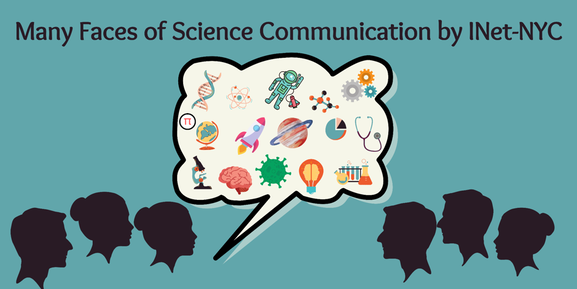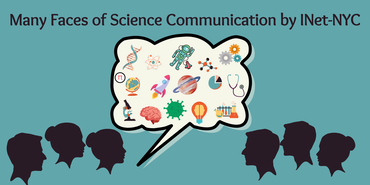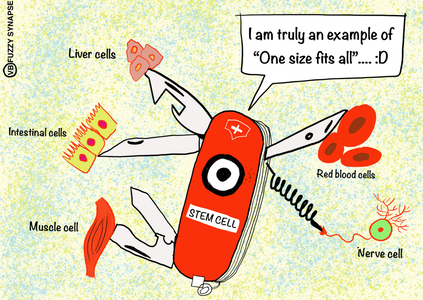|
Interview and words by Dr. Rupali Gund and Dr. Pavel Ryzhov Edited by Dr. Rinki Saha, Dr. Laurie Herviou and Dr. Conchi Izquierdo Social media is a great technological gift for our generation that allows new ways of communicating and expressing one’s ideas with a wider audience in various formats. For our second session in the science communication series, INet-NYC interviewed Dr. Pavel Ryzhov who is the creator of an online platform and Youtube channel called Biofilm News and Biofilm Podcasts. This platform covers the latest news in healthcare and life sciences and interviews experts in the biotech industry. Here are the excerpts from the conversation with Dr. Ryzhov. 1. Please share your scientific journey and path to becoming a science communicator. I had a couple of different transition points in my career trajectory. I’m originally from Russia and after graduating high school there, I came to the US in 2010 to attend community college in San Diego, California. After that, I went to Germany to continue my undergraduate studies in a little town called Rheinbach, where I got my Bachelor’s in Applied Biology. I went back to San Diego for my PhD programme in Sanford Burnham Prebys Medical Discovery Institute where I worked in the membrane protein NMR field for several years and I graduated in Feb 2020. I moved to the East Coast in the fall of 2020 to start my current job as an Application Scientist at Applied Photophysics. I believe my communication skills definitely helped me excel in my career. For my current job, I communicated with the company’s representatives over many years as part of my networking and apply my communication skills in this role to interface with the scientists, our existing and prospective new customers and to share the new products that the company is making and troubleshoot if they are having issues using our instruments. 2. It’s great to see that you had an intercontinental work experience with multi-lingual team members and how effective communication helped you land in your current role. You have created Biofilm News, would you like to share what Biofilm News is and what inspired you to start this initiative? Thank you for bringing this up! The way to describe the inspiration behind Biofilm News is to say I watch a lot of youtube videos and I am inspired by watching various podcasts or people covering news and talking about the latest tech by developing movies. As a user of these virtual platforms, I was always curious about how to create such similar content. So during my PhD, I thought of creating some videos because I realized that there is not much content available exclusively for life science students. So, I started doing short videos on some of the topics that I used to read about on a daily basis. I had to put it on hold while I was trying to finish my PhD and when I got my current job. But this year I’m taking it rather more seriously and creating content for PhD students based on my own experience, interviewing people from the industry and covering biopharma industry news that I find interesting. 3. It is fascinating to see how you are using your past career experiences and communication skills to help the wider community of life sciences students navigate their scientific journey. Exactly, I feel PhD students can have tunnel vision and I'm the first to say I'm guilty of that because we're so focused on getting our research done. We do that at the expense of knowing the larger trends in the pharma industry or life science field as a whole. Finishing a Phd could be a daunting experience, so I believe sharing some advice with students as well as sharing some of the larger things that are going on in the industry is how I would like to help a younger group of scientists. 4. What kind of content are you developing for Biofilm News and where do you publish your work in social media? There are three things that I like to focus on- 1) talking about the latest news in the industry that I find myself either on Linkedin or elsewhere, 2) interview people from the biopharma industry to learn about their experiences, and 3) sharing my own PhD experience. As far as putting it out there, I put it on YouTube and occasionally I put it on some other outlets like LinkedIn, Facebook or other personal social media channels. 5. Did you take any special courses or training to develop videos or podcasts? What suggestions do you have for our audience if they want to start their own podcasts?
I believe that the best way to start is to actually look up youtube tutorials on selecting camera gear, formatting the podcast, editing, and publishing videos, and also there are resources on how to market your content. There is so much educational content that is completely free and available. That’s how I started. I also took "The Art of Science Communication" online course offered by the American Society of Biochemistry and Molecular Biology that helped me to learn how to present my research work to the lay audience. Also, I got many opportunities during my PhD to practice science communication by doing poster presentations and sharing my research progress to my lab peers, or by having casual conversations with my friends who are not from life sciences and responding to their questions about how vaccines work or about coronavirus, all of which helped me to hone my communication skills. 6. How do you balance your work with managing Biofilms? How much time/effort goes in developing this content? The short answer is it is hard. It's definitely a fine balancing act between the work that I do and this hobby, so I try to be creative and find ways to simplify making videos and minimize the time I spend on the individual project. Sometimes perfectionism comes in my way and I keep editing a video and never publish it because you are never satisfied with the final version. So, I like to streamline that process and make it as easy as possible. Sometimes I just publish and move on to the next one. I believe setting deadlines is important and sticking to the schedule helps me to continue developing my content. 7. Where do you see Biofilm News in the next few years? Are you open to collaborating with other scientists to contribute to Biofilm News? I am looking for a co-host for a specific iteration of my podcast where I discuss the latest news because it gets really boring talking to myself while discussing the news alone on a podcast. So I feel having somebody for a banter or exchange of ideas would be awesome. So anybody who might be interested can connect with me on LinkedIn. 8. Would you like to be a science communicator full time, or keep this as a hobby? It is an interesting question now that I’m thinking. I am doing science communication as an application scientist in a full time job, because my current role is all about communicating science effectively and I enjoy doing that a lot. And, my YouTube channel is just another outlet for that. I know I will be a Science Communicator for many years and my goal is to evolve and try to develop different kinds of content and reach a wider audience. 9. What advice do you have for those who want to begin their journey in becoming a science communicator? The best way to do that is just to start talking to somebody. I've done a lot of tutoring over the years that definitely helps with learning how to talk about complex topics that would make sense to another person. Consider taking some specific communication courses if you can. I think there are vast amounts of resources and tutorials that are available on YouTube or other platforms that are freely available that I explore to develop my content. I also use Davinci Resolve free software for video editing, Microsoft Powerpoint, Affinity Designer, Canva, and Adobe illustrator. I am happy to help and share some personal tricks, if somebody wants any advice from me. The entire team of INet NYC would like to thank Dr. Pavel Ryzhov for taking time to interact with us and sharing his exciting journey of becoming a science communicator. You can connect with Dr. Ryzhov via his LinkedIn if you want to collaborate or participate in Biofilm podcasts. To follow the latest healthcare/pharma news and interviews on Biofilm News, please subscribe to Dr. Ryzhov youtube channel here.
0 Comments
Interview and words by: Dr. Rinki Saha Edited by: Dr. Laurie Herviou, Dr. Rupali Gund and Dr. Conchi Izquierdo  ‘One picture is worth ten thousand words.’ How many times you have thought if there was a diagram, I would have memorized this easily. Well, June is the month of effective science communication. We from INetNYC took this opportunity to launch our series where we will interview many science communicators from different backgrounds and different skill sets. This time we were lucky to interview the creator of Fuzzy Synapse – this platform explains various scientific topics in a fun and simple way. Fuzzy Synapse has covered various topics ranging from the theory of relativity while portraying the complex science behind microwave invention. 1. We would like to know the human behind the Fuzzy Synapse! I am Dr. Vinita Bharat, Neuroscientist at Stanford University. I finished my doctoral studies; being an International Max Planck Research School (IMPRS) Neuroscience student at European Neuroscience Institute, Goettingen, Germany. My research was focused on the exciting topic of how our brain learns and memorizes. Science has always been compelling to me, while doing my Ph.D. I understood the need of communicating science to the world. I started an online platform in 2017 called Fuzzy Synapse. With this platform, I create content to simplify complex scientific concepts in an easy and fun way. So, you can call me “the scientist who loves communicating science to broader audience.” 2. When did you illustrate something for science for the first time? Was there someone in particular who inspired you to start Fuzzy Synapse? I have always been keen on doodling; I would always love pictorially explaining myself any complex topic. I think visual illustration always makes a better impression on our minds. From our textbooks, we probably have forgotten many things, but some schematics are still in our minds. There is a very fun story that happened during my Ph.D which I would love to share. During those years, CRISPR was a new discovery, everyone in the scientific community was talking about it. I made some doodles explaining CRISPR technique. My friends and colleagues really liked it and encouraged me to post it on social media, and to my surprise, it really got a huge appraisal. That was kind of the starting point of my journey as a science communicator through Fuzzy Synapse. Fuzzy Synapse represented stem cell as "Swiss army knife” which basically holds the ability of multiple tools in one. To answer your second question, it’s very hard to pinpoint one artist as a role model given the variety of mediums people use to communicate science. From my initial days, Stempeers have given me great support and opportunity to grow my platform. I found amazing sci-comm artists through STEMPEERS. I love following and learning from each and every one’s art and way of science communication. To add a few more names, I enjoy science sketches, exemplary work from Dr.David Goodsell. Also, PHD comic series is something that makes me laugh every time.
3. Is there any exciting story behind the name Fuzzy Synapse? I want to give credit to my husband who coined this name for my platform. I think the connection between the world and science is fuzzy and being from a neuroscience background, connection means synapse. I think this name Fuzzy Synapse aligns very well with my interest and the mission of this platform really well. 4. The ratio between science communicators and scientists is not high: in your opinion, how should we tackle this issue? I think scientists should learn the art of communicating their science to the broader audience. Especially from this pandemic, we learned that we are not just fighting pandemic but also infodemic. Through science communication we should bring science and society closer. Describing the significance of your work without using jargon could be very difficult as we the scientists have no formal training in that. I think teaching effective science communication from the very start can help. I am working on curating a seminar series on effective science communication which might also help in this direction. 5. What software/applications are you using to work on your projects? When I started, I was simply using pen and paper to create illustrations. Now, I heavily use Procreate and Adobe illustrator to create all the artsy stuff. These softwares give more dimensions to my work but I feel the idea is the key. 6. How are you running the platform and how do you manage to balance your lab life and your passion side by side? I try to balance both sides. I aim to cover at least one scientific topic every week through Fuzzy Synapse. So far, I have covered around 170 topics through my art. I make sure to bring the science correctly, hence do my homework too before starting the idea. I also make a conscious effort to make my content more diverse and inclusive. Collaborating with amazing groups and individual contributors gives me a great opportunity to fine tune my ideas. I learned a lot in this whole process which has kept me motivated so far. I would say actually working in the lab brings a lot of ideas for Fuzzy Synapse. Let's say if I am running a Polymerase Chain Reaction (PCR) or working with stem cells, I think then to create illustrations on those topics. After a long day of work at the lab, thinking and creating these illustrations give me immense joy. I would say it’s hard keeping a balance between lab work and Fuzzy Synapse, but the oxytocin I get from this creation keeps me going. 7. What is the future for the platform Fuzzy Synapse? I am planning to launch a book series that will cover more scientific topics in greater detail. I am working on a book project called ‘draw your science’. Besides another ongoing series called “Draw your neuroscience” where I aim to make neuroscience fun and easy for all. I am aiming to soon launch a workshop series on effective science communication. I envision Fuzzy Synapse will be a collaborative platform for scientists and artists to collaborate. Be it through visual illustrations, art performances, podcasts etc., we will see an amazing amalgamation of both sides to communicate science. 8. What advice would you give to people who want to start with Science Communication? Just start, don’t complicate your thought process, don’t be hesitant. Please make sure to spread the right message through your content. It’s a learning process, so just put your ideas out. Collaborate with others in the field and keep learning and creating. To enjoy illustrations from Fuzzy Synapse follow her on Facebook , Instagram and twitter too! Words by Lucie Yammine Edited by Laurie Herviou, Conchi Izquierdo and Rinki Saha A few cliches about scientists are that we constantly think about science, always buried in some obscure book with formulas that only us can understand or mixing colorful solutions and exploding chemicals. While this might be an exaggeration - to some extent, we do think science, see science and talk science. Then, why wouldn’t we listen to science too? What do you listen to when you are seated in front of your computer analyzing excel spreadsheets, when you are coding or when you are at your bench doing experiments? Is it the same playlist that you always listen to? Why don’t you try listening to some podcasts! Depending on the length of the episodes you’d prefer, you could try one or the others in this list. Although not exhaustive, this list could help you get started. Although many podcasts are available, their subjects are not always as broad as the ones in this list, but maybe you can find a good fit for you elsewhere. If you are interested in astronomy, you should know that NASA has different podcasts, among which the appraised Houston We Have a Podcast. If you are more of an animal lover, you could give Creature Features a try. What about your interest in human behavior? Well, NPR’s podcast Invisiblia is one I would recommend listening to. Without further ado, here are my top 3 science related podcasts, that you can find on most podcasts hosting platforms.  This podcast is a big mix of different topics. You can learn about anything without any prior knowledge on the subject. Because all-ologies are beautiful from archaeology, ecology, neurology to psychology; so choose your topic and learn more about it. The host, Alie Ward, invites specialists to discuss science and makes asides to explain in simpler words some technical terms, which makes it accessible whatever your scientific level is. Most episodes are over an hour long to deeply dive into these-ologies. If you’ve ever wondered how many babies can mom scorpios have, you can check the Scorpiology episode, and go from there! Credits: www.alieward.com  The show is based on using scientific facts to battle or to confirm myths and trending subjects. Not surprising that a lot of the latest episodes are coronavirus related but with 9 seasons and hundreds of episodes, you will definitely find some subjects of interest! The episodes are roughly 30 minutes long, and the host Wendy Zukerman's jovial voice makes them easy to listen to when you just need a little pinch of science. Personal choices to try out are Race: Can We See It In Our DNA or Chiropractors. Credits: www.grimletmedia.com  It is said that taking a step back from your work for a minute can help you get your ideas in order. What about listening to unrelated science during that minute? That might help clear your mind with a two or three minutes long podcast. Take a look at the hundreds of podcasts in this series or learn more about how Flamingos Can Be Picky about Company or how Mars-Quakes, Could Reveal How Mars Was Built here. Credits: www.podcasts.apple.com If you need any more science in your life, I hope these suggestions will nurture your curiosity. Or maybe you are outraged that one of your favorite podcasts didn’t make it into my short-list, tell me more!
|
Archives
May 2025
Categories
All
|




 RSS Feed
RSS Feed